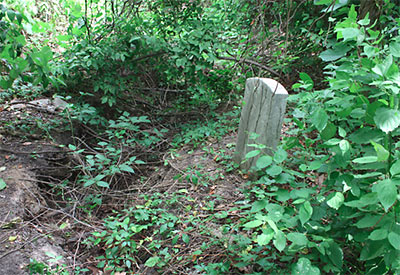COMMENT OF THE DAY: CAN WE LAY TO REST THAT POSITIVE VIEW OF HISTORY?  “If one of the Georges (or let’s say King George to round things out a little) happened to have been responsible for the destruction of some place — notable or otherwise, regarded as new or old at that particular moment in time — is that not an event deserving the adjective historical? Why must history be construed to reflect the addition to some facet of our tangible world, and never a subtraction from it? Is a repository of construction waste not historic simply because it lacks gingerbread affectations? If cemeteries can be historic, then why not a dump? . . . As a society, I think that we must acknowledge that the physical manifestation of our civilization is an ongoing work in progress. We should not mortgage our future to honor the past in this way.” [TheNiche, commenting on Comment of the Day: History is in the Eye of the Deedholder; previously on Swamplot] Photo of eroded grave in Olivewood Cemetery, ca. 2010:  J.R. Gonzales
“If one of the Georges (or let’s say King George to round things out a little) happened to have been responsible for the destruction of some place — notable or otherwise, regarded as new or old at that particular moment in time — is that not an event deserving the adjective historical? Why must history be construed to reflect the addition to some facet of our tangible world, and never a subtraction from it? Is a repository of construction waste not historic simply because it lacks gingerbread affectations? If cemeteries can be historic, then why not a dump? . . . As a society, I think that we must acknowledge that the physical manifestation of our civilization is an ongoing work in progress. We should not mortgage our future to honor the past in this way.” [TheNiche, commenting on Comment of the Day: History is in the Eye of the Deedholder; previously on Swamplot] Photo of eroded grave in Olivewood Cemetery, ca. 2010:  J.R. Gonzales





I see what you’re doing Niche. If everything is historical then nothing is historical. We can all just forget about any designations or protections and let developers do whatever they want….
.
That said you do raise a good point in the first part of your post. Is the destruction of something historical, not itself historical? I would say yes it is. I can point to the destruction of the famous Romanesque Church at Cluny in France as an example. The demolition of the Singer Building in New York as another.
Regarding “historical dumps”, part of the neighborhood of Testaccio in Rome would classify as such and has revealed archaeological evidence of discarded refuse brought in from as far as Spain and North Africa. Today it hosts some of the most swinging discotechs in Europe.
It isn’t that complicated. History is mostly preserved in books in libraries with a few artifacts in museums. There are a very small number of historic events that are so significant that preserving the location where they happened is worth doing for cultural and educational purposes. Even in places rich in history like Boston and Philadelphia, you need a map to find these places. Historic preservation that manifests itself in historic districts and landmarks is not about history per se. It is primarily about architecture and culture. For those of us who do not split our time between reading Fountainhead for the seventh time and staring at a Forex screen all day, there are certain small parts of very large cities where architecture from well recognized periods (craftsman, victorian, mid-century, etc.) exist in a unique original layout (i.e. neighborhoods where you can walk from a house to a store without crossing a six lane major thorough fare lined with big box retail) that are very much worth preserving for both the benefit of those who live there and those who visit. The idea that these few tiny hamlets of preservation in the middle of massive cities impede human progress is just flat out silly. If anything, human progress is impeded when we erase all physical manifestations of our past and the great architecture of those who came before us. Unfortunately, the architecture of the present has devolved to not much more than a Sim City-esque game where people mash up architectural styles on computer CAD programs to spit out designs that maximize profit with ruthless efficiency. So, it is understandable that the small group of people involved in constructing the architecture of today would not want to be reminded of the great works of the past.
Oh and I forgot the most historic of them all – though it wasn’t actually a demolition: the proposed demolition of Grand Central Terminal in New York City. There was a furor. Jackie O’ got involved. As did Ed Koch. It was a huge deal – historically.